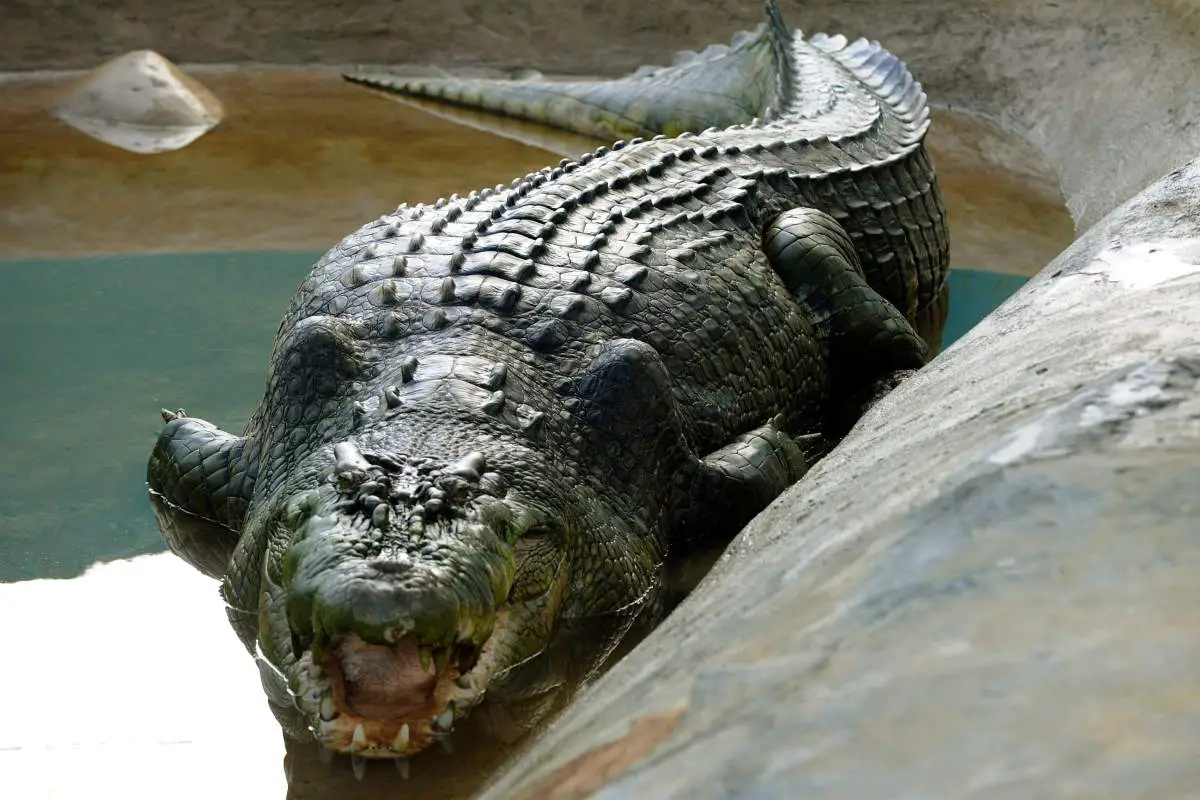The biggest crocodile ever held in captivity, also the largest crocodile ever properly measured, Lolong, a saltwater crocodile, stretched an astonishing 6.17 meters (20 feet 3 inches) and weighed a colossal 1,075 kg (2,370 lb). In 2011, his immense size caught the attention of the zoologists. Upon careful measurement, scientists confirmed Lolong’s title as the world’s largest captive crocodile. Tragically, on February 10, 2013, this magnificent creature succumbed to pneumonia and cardiac arrest. Here is the story of Lolong.
Saltwater crocodile: the biggest crocodile species in the world
Crocodiles, particularly the saltwater crocodile species, are widely recognized as the most colossal living reptiles in terms of both size and weight. The sheer size of these ancient creatures has always fascinated humanity, with particularly immense specimens drawing significant mainstream intrigue. This fascination, however, is frequently amplified by embellished tales and hyperbolic descriptions of their stature and habits.
While many stories and images paint a fantastical picture of their dimensions, concrete evidence determining the utmost size of these reptiles remains elusive. Historical artifacts, such as crocodile skulls preserved in museums and private collections, offer intriguing insights into the potential enormity of these creatures. Unfortunately, they often fall short of providing a comprehensive view; the total length is seldom documented, the methods used to gauge them remain mysterious, and the authenticity of these measurements often stands on shaky ground.
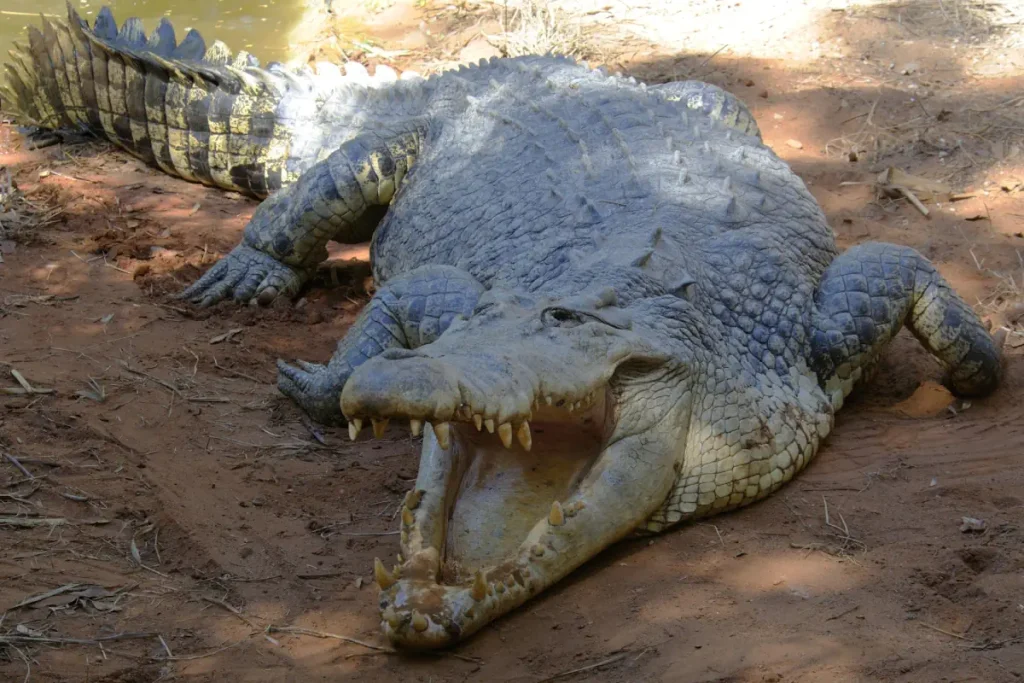
Due to their imposing size and fearsome reputation, crocodiles often become the subjects of “big fish” stories. The term “big fish story” is an idiom rooted in the age-old tradition where fishermen exaggerate the size of their catch. Similarly, stories about crocodiles frequently become embellished over time, turning these already impressive creatures into the stuff of legend. Whether it’s the length of the crocodile, the number seen, or the danger of an encounter, these tales can grow in magnitude with each telling. Such exaggerations highlight humanity’s deep-rooted fascination with these ancient reptiles and our tendency to amplify the extraordinary.
Story of Lolong: The biggest crocodile in the world that properly measured
However, in the case of Lolong, the reality matched the legend. Unlike many exaggerated accounts, Lolong’s size was meticulously documented. In 2011, scientists measured this gargantuan creature. The results were undeniable: at 6.17 meters (20 feet 3 inches) and weighing 1,075 kg (2,370 lb), Lolong was a true titan of the crocodile world.
The capture of Lolong
In September 2011, global attention turned to a creek near Bunawan, Agusan del Sur province, Mindanao, Philippines, where an enormous male saltwater crocodile was captured. This behemoth was believed to be responsible for the tragic death of 12-year-old Rowena Romano in Lake Mihaba in 2009 and the mysterious disappearance of a fisherman in 2011.
The local community and authorities had pursued the creature for two years. Sadly, a key figure in the capture, Ernesto “Lolong” Cañete from the Palawan Wildlife Rescue and Conservation Center (PWRCC), passed away from a heart attack right before the mission’s success. In his honor, the crocodile was named “Lolong.”
Ronnie Sumiller, a wildlife specialist, along with the PWRCC team, orchestrated Lolong’s capture. They used steel nooses baited with Carabao (the Philippine English term for the water buffalo) meat, suspended from the surrounding trees. The mighty crocodile managed to break the first four nooses, but the fifth, made of a more durable cable, finally restrained it. The remnants of the previous attempts were found wrapped around Lolong’s upper jaw.
To bring the massive creature ashore, a team of dozens hauled and secured it with ropes. Phone guidance came from PWRCC experts absent during the event. Astoundingly, over 100 locals were required to transport Lolong to a nearby village using a cart. They even built a makeshift pontoon to move him across the creek. The journey ended at the Bunawan Eco-Park and Research Center, where the legendary crocodile found its new home.
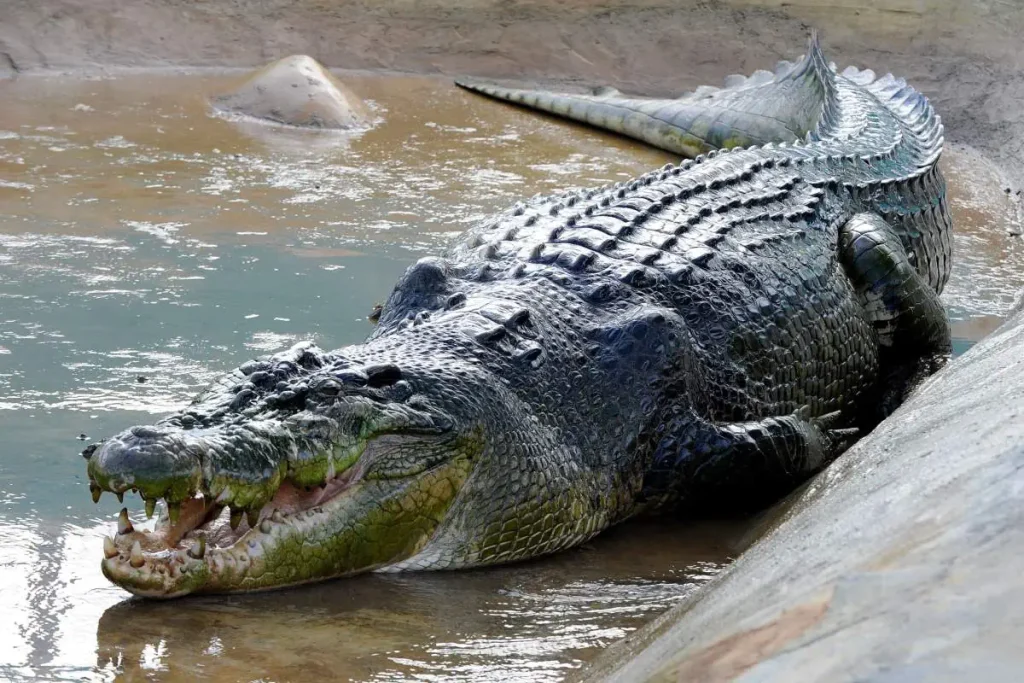
How big was Lolong? Early estimates
Since Lolong was so big, the international community was deeply intrigued by the precise length of Lolong. Before the capture, an eyewitness claimed that the crocodile responsible for Rowena Romano’s death measured “30 feet” (9.1 meters), while another one seen near a village, preying on a carabao, was believed to be about “16 feet” (4.9 meters).
Lolong’s true dimensions only became clear when he was caught. Media figures on his size varied, suggesting anything from 6.1 to 6.4 meters (20-21 feet). Bunawan Mayor Edwin Elorde, for example, measured Lolong’s length at 6.4 meters (21 feet).
It was unclear how these measurements were taken, their accuracy, or their reporting veracity. Yet, pictures and videos showcased Lolong’s remarkable size, prompting significant interest in getting an accurate measure. Natural History New Zealand sent one of the authors to Bunawan for an independent measurement, observation, and documentation. This endeavor was financially backed by National Geographic.
How to measure the biggest crocodile ever captured: measuring Lolong
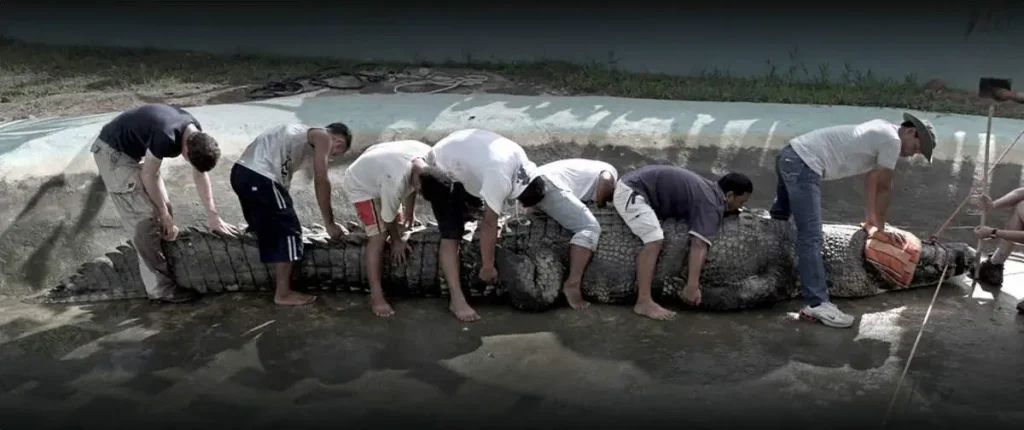
On November 9, 2011, at 2:00 PM local time, zoologists took measurements of Lolong at Bunawan Eco-Park. The setting was optimal for this procedure. Lolong lay straight on the flat surface of an emptied pool. To ensure accurate measurement, as well as safety for both the staff and the crocodile, a mix of chemical and physical restraint methods was utilized.
Chemical restraint involved using pancuronium bromide, given in two doses of 2 mg each, with a 40-minute gap, aiming for temporary semi-immobilization. Additionally, a single dose of 10 mg of diazepam was administered for light sedation. Both medications were injected into different sides of the crocodile’s tail. As there was no prior use of these drugs on a crocodile of Lolong’s size, minimal dosages were chosen to prioritize safety. Throughout, the crocodile’s breathing rate and eye reflexes were observed.
After two hours, Lolong could only manage sluggish movements of his head, extremities, and tail end. Then, physical restraint methods were applied: ropes were used to secure and close the jaws, and damp towels covered his eyes to minimize visual stimuli. With a team of five, they approached the crocodile from the rear. They pressed down on various parts of his body and raised each limb to restrict movement. Duct tape was used to keep the jaws shut, leaving the nostrils open for breathing. After ensuring the crocodile was safely restrained, measurements were taken. This process lasted roughly an hour.
Afterward, all restraints were cautiously removed following standard safety procedures. No antidote was given for the pancuronium bromide; instead, it was left to wear off naturally. Six hours after the procedure, Lolong was observed to be moving comfortably within his enclosure.
![Measuring the biggest crocodile [Lolong]](https://cdn-0.ourplnt.com/wp-content/uploads/2023/08/Lolong-biggest-crocodile-measurement-diagram-890x1024.webp)
Before measuring, Lolong’s head and tail were carefully straightened. He held this position throughout the process. The primary focus of the measurements was on the head dimensions and body length, as these were less likely to be affected by the body’s condition, unlike variables such as belly width. A flexible, non-stretchable steel tape marked in millimeters was used for measuring, and conversions to other units, like feet, were done post-measurement. For precise measurements, the tape was kept tight, and straight wooden rods were used to mark specific endpoints.
There isn’t a universally accepted method for measuring crocodilian sizes. The team measured Lolong adapted methods used for saltwater crocodiles, with some modifications based on their hands-on experience with wild crocodiles. The term DCL was specifically used for “head length” to avoid confusion with skull measurements, as there have been past mix-ups between mandible length and head length.
The broadest points determined skull widths and heights. They used Snout-pelvis length, the distance to where the hind legs join the pelvis, as a stand-in for snout-vent length (SVL). This was because flipping such a massive crocodile on its back on concrete was not only challenging but raised concerns for its well-being. It’s worth noting that the difference between SPL and SVL is typically less than 1%.
Acknowledging potential debates over the best method for measuring body length, two approaches were used. Method A traced a steel tape along the top middle line from the snout to the tail tip, following the skull’s curve and the tail’s latter part. Method B measured the horizontal distance between the snout and tail tip, strictly parallel to the ground.
In practice, Method B typically yielded slightly shorter results than Method A, especially for larger specimens. However, Method A is more commonly applied because it’s more convenient, especially with big crocodiles that are hard to reposition. Consequently, measurements using Method A are more relevant for comparisons with other large crocodiles. It’s important to note that there seemed to be no damage to Lolong’s tail tip.
The length of the biggest crocodile ever recorded: 6.17 meters [20 feet and 2.91 inches or 20.24 feet]
Using Method A, the team measured Lolong’s total length (TL) at 6.17 meters (20.24 feet or 20 feet and 2.91 inches), with a dorsal cranial length (DCL) of 700 mm (27.6 inches).
The ratio of DCL to TL was 1:8.8. Snout-pelvis length (SPL) was 2.85 meters (9.35 feet). Therefore tail length (TaL) was 3.32 meters (10.89 feet), with TaL to TL ratio of 1:1.9.
Snout-scute junction (SSJ) was 4.98 meters (16.34 ft), therefore the team calculated anterior tail length (TaL1) as 2.13 meters (6.99 feet) and posterior tail length (TaL2) as 1.19 meters (3.90 feet). The ratio TaL2 to TaL is 1:2.8.
Measurements using Method B provided almost the same result. All measurements differed by less than 1% between Methods A and B except TL, which differed by 1.2%.
Lolong’s net mass (accounting for the trailer weight) was 1,075 kg (2,370 lbs), which was recorded at a nearby truck weigh-bridge during transport to his captive holding facilities on September 3, 2011.
Lolong’s total length (TL), at 6.17 meters (20.24 feet), makes him the largest wild crocodile ever captured alive.
The condition of Lolong during the measurement
Scientists noted that Lolong’s general body condition was good, exhibiting normal muscle structure and fat layers expected of a mature wild crocodile. While age cannot be ascertained merely through physical examination, there were no clear indications of old age.
Based on features like skull texture, tooth socket health, prominence of dorsal scutes, and overall appearance, his age was roughly estimated to be between 50 to 60 years. These estimates drew comparisons with previous observations. Surprisingly, for such a large wild crocodile, Lolong had minimal historical scars. No parts, such as limbs, toes, or tail sections, were missing.
The underside of the crocodile wasn’t inspected. Some recent minor injuries, visible in areas like the foot pads, sides, back plates, and snout, likely resulted from rope friction during his capture and transfer. All these fresh wounds were on the mend; most of the scabs had shed, unveiling new skin that was either not yet colored or only partially so.
How Lolong died
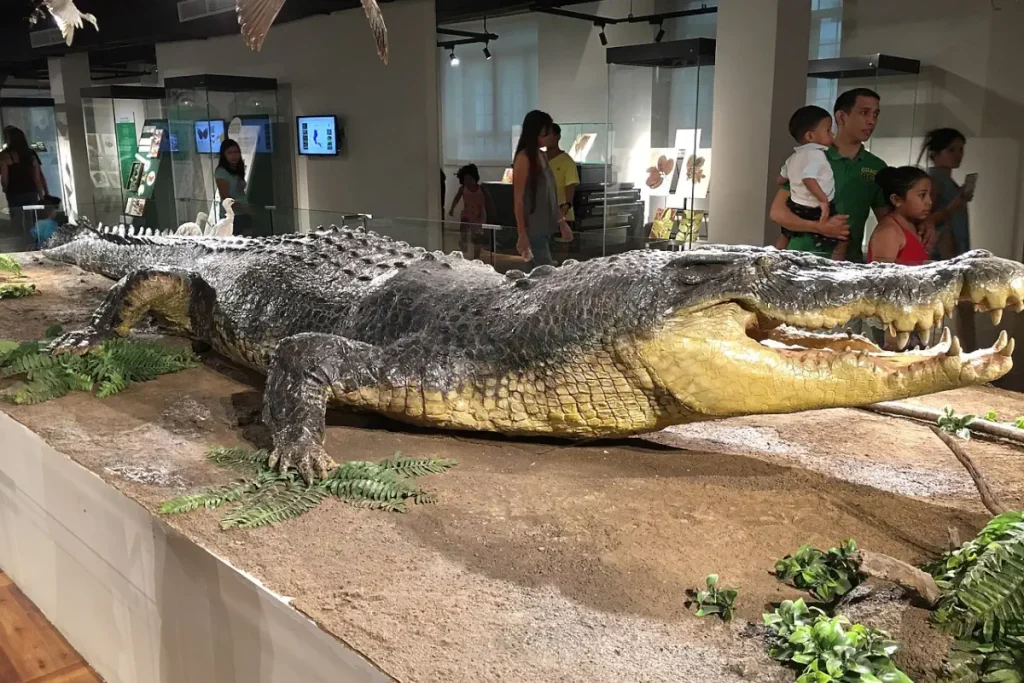
On the evening of 10 February 2013, around 8:00 p.m., Lolong was discovered dead within his enclosure. A subsequent necropsy pointed to a combination of factors leading to his death. Pneumonia and a resultant cardiac arrest were identified as primary causes. These conditions were further exacerbated by a fungal infection and undue stress.
The circumstances of his death sparked a debate among wildlife activists and experts. Some argue that captivity played a significant role in hastening his demise, suggesting that the environmental and psychological stressors inherent to confinement might have adversely impacted his health. However, some scientists offer a counter perspective, asserting that captivity wasn’t the underlying cause of Lolong’s death.
According to them, Lolong’s enclosure might not look pretty, but, in fact, crocodiles in the wild call muddy holes “home”, they just look for any kind of shelter and the basic necessities for survival. So, Lolong was provided with those basic necessities. Crocodiles do not eat if they’re too stressed, but in Lolong’s case, he was eating and seemed to settle down into his new surroundings and was behaving normally.
Scientists say “Anyone who actually met his caretakers would have realized he was well-loved. You might say they adored him.” He adds: “…there were also financial incentives to keep Lolong alive; he was popular, brought much money into the community, and generated a lot of national and international attention.”
So, despite his living environment looking terrible to an unfamiliar eye, Lolong was actually well cared for.
Scientists further explain:
“Lolong’s death has inevitably raised questions about whether he should have been captured in the first place, and indeed whether any crocodiles should ever be kept in captivity. Animal rights issues aside, it seems many have forgotten the reason that Lolong was captured in the first place.”
“He was a wanted crocodile; poison baits had been set out by the local community to kill him, and more direct methods would have been used if the opportunity arose. Few people will tolerate a killer crocodile in their midst, and why should they? Crocodiles that attack people develop a dangerous knowledge that humans can be easy prey, and it is well known that they will return to an area again in the future to look for more.”
“This is a real fear for people who live alongside crocodiles, and no matter how much you love crocodiles it makes sense to remove such antagonistic individuals to better protect the remaining wild population, particularly in a country with little love for crocodiles in the first place. So what do you do when the wild population is so rare? It’s a no-win situation.”
So, they conclude:
“It would have been ideal to leave Lolong in the wild, but does such specious thinking have a place in our overcrowded world? A conflict between humans and wildlife can have major repercussions for conservation (not to mention human safety, which any level-headed human regards as being of prime importance). Yet at the same time, we can’t simply remove all wild animals simply because it makes us feel better, or safer. There has to be a compromise, and unfortunately for Lolong, he was that compromise at that particular time and place. Perhaps his death can be a lesson for us.”
After Lolong’s death, the official Guinness World Record for the longest crocodile in captivity reverts back to Cassius, a 5.48 meters (17 feet and 11 inches) long saltwater crocodile living on Green Island in Queensland, Australia. Yet Lolong remains, in spite of his death, the largest crocodile that has ever been accurately measured.
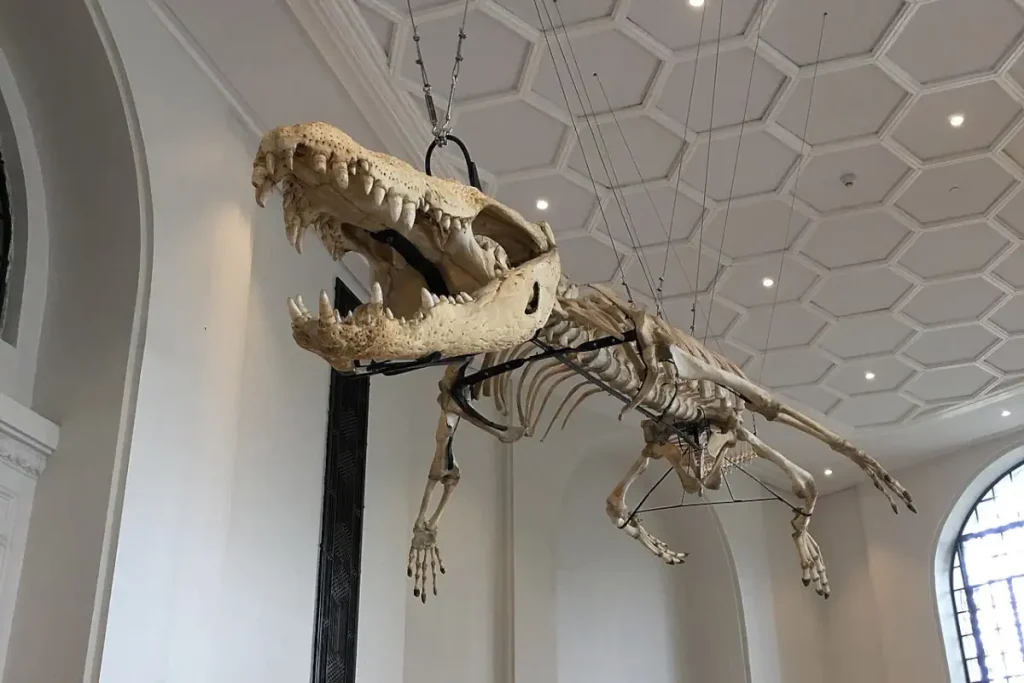
Sources
- Measuring Lolong – “Here be a dragon: exceptional size in a saltwater crocodile (Crocodylus porosus) from the Philippines”. N. Whitaker, R. E. Whitaker. Link: Research Gate
- The biggest crocodile in captivity: Lolong on Wikipedia
- How Many Elephants are Left in the World in 2025? - August 17, 2025
- Moon Landings: All-Time List [1966-2025] - February 2, 2025
- What Is Max-Q and Why Is It Important During Rocket Launches? - January 16, 2025
